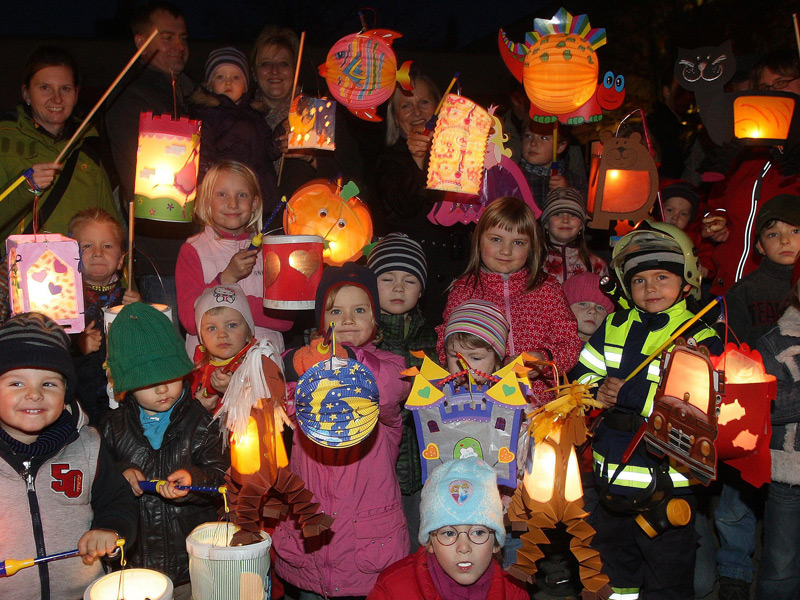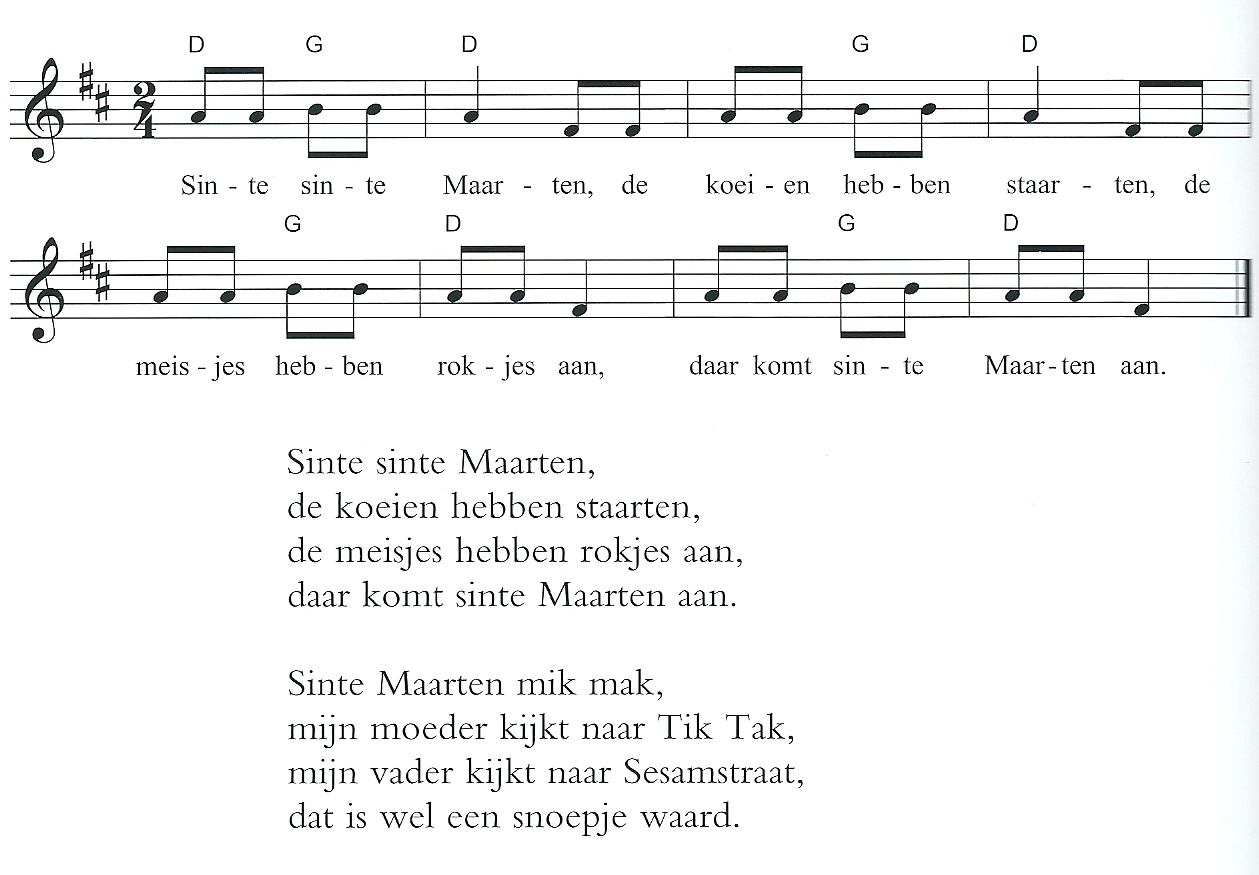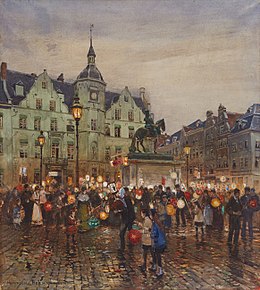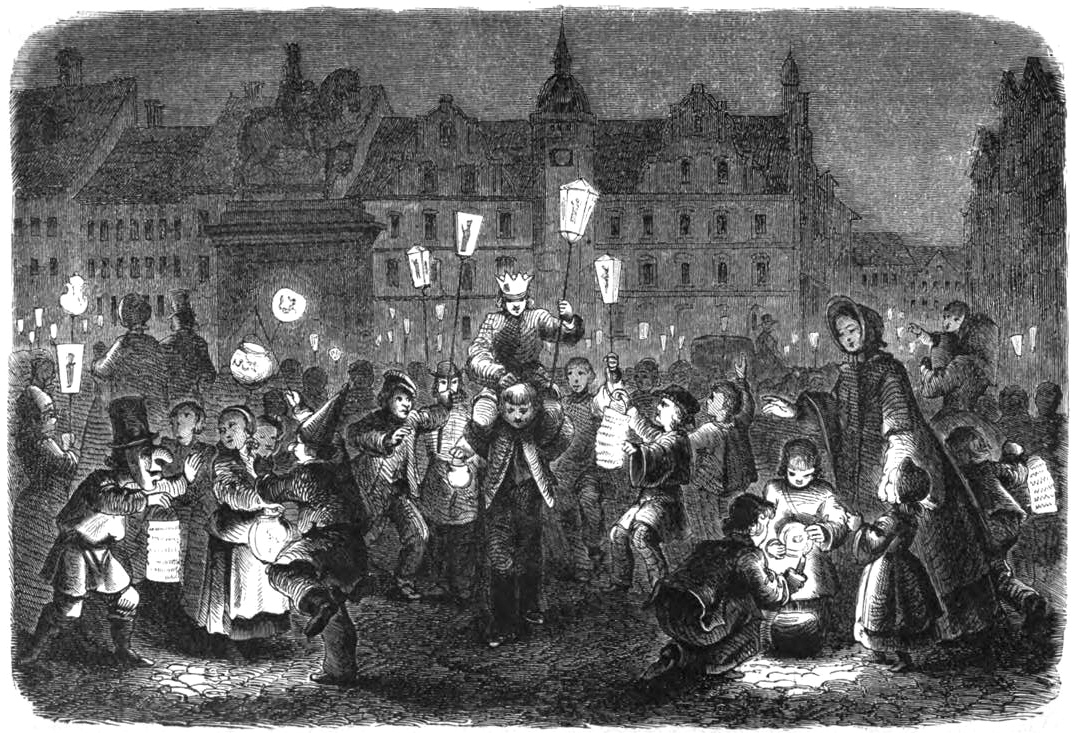11 november is de dag…

The 11th of November is St Maarten!
Here in Utrecht, St Maarten is the patron saint and his day is often celebrated by popular culture. Children make (or buy) small lamps, earlier out of sugar-beets or large root vegetables but now, out of paper, drawings, stickers and often small bike lights or torches. They tour the neighbourhoods, knocking on doors and singing songs in exchange for sweets.
For some the festival has religious history and for others, it’s based on the essential charity many needed to survive the winter. It’s also about the light and warmth everybody shares to get them through the darker months.
Here are some children in the Zaanstreek making lanterns in 1961.
Sint-Maarten

Sinte Sinte Maarten

Dutch Wikipedia says…
Over de ontstaansgeschiedenis van het feest wordt veel gespeculeerd. Vaak wordt verondersteld dat het feest teruggrijpt op een Germaans winterfeest, maar ook een zuiver kerkelijke oorsprong is mogelijk. Wel duidelijk is dat de ontwikkeling tot een algemeen, door alle gezindten gevierd, volksfeest tamelijk recent is.
De Schotse antropoloog James Frazer veronderstelt een heidense oorsprong van het feest: het ronddragen van het (heilige) vuur zou een voorchristelijk vruchtbaarheidsritueel zijn, wijdverspreid over West-Europa. Het heidense ritueel zou dan door de kerk zijn overgenomen, vooral om het vertrouwen van de bevolking te winnen.[1] Andere onderzoekers stellen echter dat er niets heidens aan het feest valt op te merken. Het feest zou door de kerk zijn geïntroduceerd. In het Lucasevangelie staat de tekst: Niemand steekt een lamp aan en zet die in de kelder of onder de korenmaat, maar op de standaard, opdat wie binnentreden het licht zien (Lukas 11:33 e.v.). Deze regels werden vaak op 11 november voorgedragen en in de mis besproken dit zou voor de bevolking aanleiding zijn geweest voor een lichtjesfeest. Moderne onderzoekers houden vaak het midden tussen beide standpunten. Sint-Maarten is een bedelfeest, en bedelfeesten waren nodig in de moeilijke wintermaanden. Bedeloptochten zoals met Sint-Maarten werden en worden (in Vlaanderen en sommige delen van Nederland) ook gehouden met Driekoningen of met Nieuwjaar, en ook het sinterklaasfeest heeft kenmerken van een bedelfeest.
In Nederland komt de viering voor in delen van het land. In Utrecht, waar Sint-Maarten de schutspatroon van is, is een Sint-Maartensberaad opgericht om Utrecht als Sint-Maartenstad te promoten.
Niet in iedere streek lijkt de traditie even sterk te leven; in Limburg, Noord-Holland in West-Friesland en Groningen werd in 1997 vastgesteld, dat in deze provincies de sint-maartensviering nog vrij actueel was. In de provincies Friesland, Drenthe en Noord-Brabant bleek een vermeerdering van vieringen te zijn waargenomen. In mindere mate wordt Sint-Maarten gevierd in Zuid-Holland en Zeeland en in delen van Overijssel, Flevoland en Gelderland.
Dat het feest niet verdwijnt, maar zich integendeel verder verspreidt, wordt geïllustreerd door de ontwikkeling in Amsterdam. Het feest werd hier al honderden jaren niet meer gevierd, tot het in de laatste decennia van de 20e eeuw in de buitenwijken opdook onder invloed van omliggende gemeenten in de meer agrarische gebieden. In de jaren 1990 verschenen in de Weteringbuurt en aan de Amsterdamse grachten weer de eerste lampionnen.
Aan de overkant van het IJ, in Amsterdam-Noord, werd tot na de Tweede Wereldoorlog ‘Sinteremaarten’ gevierd met een tot lampion uitgesneden koolraap, suikerbiet of voederbiet, overeenkomstig de Duitse Rübengeistern; raapgeesten, of de oorspronkelijke Ierse Jack-o’-lantern, onderdeel van de oeroude tradities van dankfeesten voor Licht, Warmte, Gewas en Oogst. Inmiddels is het sint-maartenlopen in vrijwel geheel Amsterdam een levende traditie.
De (cor)relatie van het feest met religie is niet sterk. In Nederland wordt het sint-maartensfeest gevierd door kinderen van alle gezindten. In veel liedjes wordt nauwelijks aandacht aan de religieuze achtergrond besteed. De liedjes hebben vaak een humoristisch karakter en het repertoire wordt ieder jaar aangevuld met parodiërende of satirische teksten.
11 november is ook de nationale dag van het Nederlandse deel van het eiland Sint Maarten, dat naar de heilige vernoemd is.
English language Wikipedia says…
Saint Martin’s day, also known as the Feast of Saint Martin, Martinstag or Martinmas, as well as Old Halloween and Old Hallowmas Eve,[1][2] is the feast day of Saint Martin of Tours (Martin le Miséricordieux) and is celebrated on November 11 each year. This is the time when autumn wheat seeding was completed, and the annual slaughter of fattened cattle produced “Martinmas beef”.[3] Historically, hiring fairs were held where farm laborers would seek new posts.
Saint Martin of Tours was a Roman soldier who was baptised as an adult and became a monk. The most famous legend concerning him was that he had once cut his cloak in half to share with a beggar during a snowstorm, to save the latter from the cold. That night, he dreamt of Jesus, wearing the half-cloak and saying to the angels, “Here is Martin, the Roman soldier who is now baptised; he has clothed me.” [4] Saint Martin died on November 8, 397.
Customs
St. Martin was known as friend of the children and patron of the poor.[5] This holiday originated in France, then spread to the Low Countries, the British Isles, Germany, Scandinavia, and Eastern Europe. It celebrates the end of the agrarian year and the end of the harvest.[6] Bishop Perpetuus of Tours, who died in 490, ordered fasting three days a week from the day after Saint Martin’s Day (11 November). In the 6th century, councils required fasting on all days except Saturdays and Sundays from Saint Martin’s Day to Epiphany(the Feast of the Three Wise Men and the star, c.f. Matthew 2: 1-12) on January 6, a period of 56 days, but of 40 days fasting, like the fast of Lent. It was therefore called Quadragesima Sancti Martini (Saint Martin’s Lent).[7] This period of fasting was later shortened and called “Advent” by the Church.[8]
The goose became a symbol of St. Martin of Tours because of a legend that when trying to avoid being ordained bishop he had hidden in a goose pen, where he was betrayed by the cackling of the geese. St. Martin’s feast day falls in November, when geese are ready for killing. St. Martin’s Day was an important medieval autumn feast, and the custom of eating goose spread to Sweden from France. It was primarily observed by the craftsmen and noblemen of the towns. In the peasant community, not everyone could afford to eat goose, so many ate duck or hen instead.[9]
Though no mention of Saint Martin’s connection with viticulture is made by Gregory of Tours or other early hagiographers, he is nonetheless credited with a prominent role in spreading wine-making throughout the Touraine region and facilitating the planting of many vines. The Greek myth that Aristaeus first discovered the concept of pruning the vines after watching a goat eat some of the foliage has been appropriated to Martin.[10] Martin is also credited with introducing the Chenin blanc grape varietal, from which most of the white wine of western Touraine and Anjou is made.
As with the word “Christmas”, the term Martinmas literally means “Mass of Martin”, or the day when he is honoured in the Mass. Martinmas, as a date on the calendar, has two meanings: in the agricultural calendar it marks the beginning of the natural winter, but in the economic calendar it is seen as the end of autumn. The feast coincides not only with the end of the Octave of All Saints, but with harvest-time, the time when newly produced wine is ready for drinking, and the end of winter preparations, including the butchering of animals. (An old English saying is “His Martinmas will come as it does to every hog,” meaning “he will get his comeuppance” or “everyone must die”.) Because of this, St. Martin’s Feast is much like the American Thanksgiving – a celebration of the earth’s bounty. Because it also comes before the penitential season of Advent, it is seen as a mini “carnivale”, with all the feasting and bonfires. As at Michaelmas on 29 September, goose is eaten in most places. Following these holidays, women traditionally moved their work indoors for the winter, while men would proceed to work in the forests.
In some countries, Martinmas celebrations begin at the eleventh minute of the eleventh hour of this eleventh day of the eleventh month (that is, at 11:11 am on November 11). In others, the festivities commence on St. Martin’s Eve (that is, on November 10). Bonfires are built and children carry lanterns in the streets after dark, singing songs for which they are rewarded with candy.

 Viering van Sint Maarten voor het Düsseldorfer Rathaus in 1905 en Das Martinsfest in Düsseldorf, 1863
Viering van Sint Maarten voor het Düsseldorfer Rathaus in 1905 en Das Martinsfest in Düsseldorf, 1863